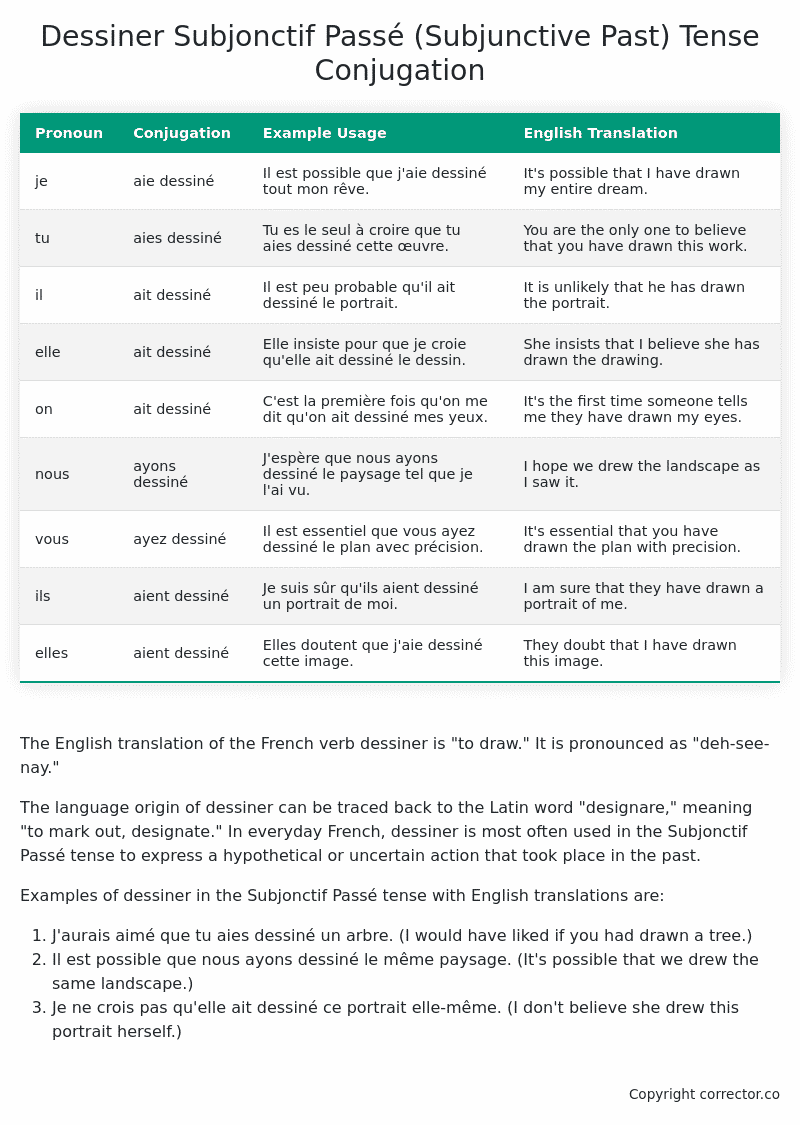Subjonctif Passé (Subjunctive Past) Tense Conjugation of the French Verb dessiner
Introduction to the verb dessiner
The English translation of the French verb dessiner is “to draw.” It is pronounced as “deh-see-nay.”
The language origin of dessiner can be traced back to the Latin word “designare,” meaning “to mark out, designate.” In everyday French, dessiner is most often used in the Subjonctif Passé tense to express a hypothetical or uncertain action that took place in the past.
Examples of dessiner in the Subjonctif Passé tense with English translations are:
- J’aurais aimé que tu aies dessiné un arbre. (I would have liked if you had drawn a tree.)
- Il est possible que nous ayons dessiné le même paysage. (It’s possible that we drew the same landscape.)
- Je ne crois pas qu’elle ait dessiné ce portrait elle-même. (I don’t believe she drew this portrait herself.)
Table of the Subjonctif Passé (Subjunctive Past) Tense Conjugation of dessiner
| Pronoun | Conjugation | Example Usage | English Translation |
|---|---|---|---|
| je | aie dessiné | Il est possible que j’aie dessiné tout mon rêve. | It’s possible that I have drawn my entire dream. |
| tu | aies dessiné | Tu es le seul à croire que tu aies dessiné cette œuvre. | You are the only one to believe that you have drawn this work. |
| il | ait dessiné | Il est peu probable qu’il ait dessiné le portrait. | It is unlikely that he has drawn the portrait. |
| elle | ait dessiné | Elle insiste pour que je croie qu’elle ait dessiné le dessin. | She insists that I believe she has drawn the drawing. |
| on | ait dessiné | C’est la première fois qu’on me dit qu’on ait dessiné mes yeux. | It’s the first time someone tells me they have drawn my eyes. |
| nous | ayons dessiné | J’espère que nous ayons dessiné le paysage tel que je l’ai vu. | I hope we drew the landscape as I saw it. |
| vous | ayez dessiné | Il est essentiel que vous ayez dessiné le plan avec précision. | It’s essential that you have drawn the plan with precision. |
| ils | aient dessiné | Je suis sûr qu’ils aient dessiné un portrait de moi. | I am sure that they have drawn a portrait of me. |
| elles | aient dessiné | Elles doutent que j’aie dessiné cette image. | They doubt that I have drawn this image. |
Other Conjugations for Dessiner.
Le Present (Present Tense) Conjugation of the French Verb dessiner
Imparfait (Imperfect) Tense Conjugation of the French Verb dessiner
Passé Simple (Simple Past) Tense Conjugation of the French Verb dessiner
Passé Composé (Present Perfect) Tense Conjugation of the French Verb dessiner
Futur Simple (Simple Future) Tense Conjugation of the French Verb dessiner
Futur Proche (Near Future) Tense Conjugation of the French Verb dessiner
Plus-que-parfait (Pluperfect) Tense Conjugation of the French Verb dessiner
Passé Antérieur (Past Anterior) Tense Conjugation of the French Verb dessiner
Futur Antérieur (Future Anterior) Tense Conjugation of the French Verb dessiner
Subjonctif Présent (Subjunctive Present) Tense Conjugation of the French Verb dessiner
Subjonctif Passé (Subjunctive Past) Tense Conjugation of the French Verb dessiner (this article)
Subjonctif Imparfait (Subjunctive Imperfect) Tense Conjugation of the French Verb dessiner
Subjonctif Plus-que-parfait (Subjunctive Pluperfect) Tense Conjugation of the French Verb dessiner
Conditionnel Présent (Conditional Present) Tense Conjugation of the French Verb dessiner
Conditionnel Passé (Conditional Past) Tense Conjugation of the French Verb dessiner
L’impératif Présent (Imperative Present) Tense Conjugation of the French Verb dessiner
L’infinitif Présent (Infinitive Present) Tense Conjugation of the French Verb dessiner
Struggling with French verbs or the language in general? Why not use our free French Grammar Checker – no registration required!
Get a FREE Download Study Sheet of this Conjugation 🔥
Simply right click the image below, click “save image” and get your free reference for the dessiner Subjonctif Passé tense conjugation!

Dessiner – About the French Subjonctif Passé (Subjunctive Past) Tense
Formation of the Subjonctif Passé
Everyday Usage Patterns
Interactions with Other Tenses
Present tense
Future tense
Conditional
Summary
I hope you enjoyed this article on the verb dessiner. Still in a learning mood? Check out another TOTALLY random French verb conjugation!


